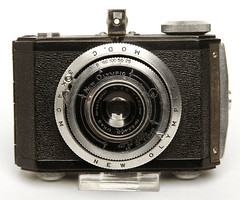Olympic
This article deals with Japanese bakelite 3×4cm and 4×4cm cameras using 127 film. For other uses of the name, see the "Olympic" disambiguation page. In particular, there are other models made (or distributed) by the same companies: the 24×36mm Super Olympic, the 4.5×6cm Semi Olympic and the 4×6.5cm Vest Olympic and Regal Olympic.
The Olympic are Japanese bakelite cameras made from 1934 to the early 1940s. They were initially distributed by Asahi Bussan, and certainly made in the company's own manufacturing facilities (see the discussion in Asahi Bussan). In late 1937, the manufacturer was bought by Riken and reorganized as the dependent Asahi Kōgaku Kōgyō (unrelated to the other Asahi Kōgaku predecessor of Pentax). After 1938 or 1939, the distribution was gradually taken over by Riken Kōgaku Kōgyō. The early Olympic cameras have an AB logo for Asahi Bussan, and later cameras have an AKK logo for Asahi Kōgaku Kōgyō.
Contents
The Olympic A, B and Junior
General description
The Olympic A, B and Junior take 3×4cm pictures on 127 film and share the same rounded bakelite body. There is a bakelite helical supporting the lens and shutter assembly and driven by a bakelite ring. This helical is used both to collapse or extend the lens and to focus the camera: there is a small distance scale on the right of the ring (as seen from the front). The advance knob is at the top right (as seen by a photographer holding the camera) and the viewfinder is in the middle of the top plate. The back is hinged to the right and has two uncovered red windows. The back is opened by pushing a button placed at the left end of the body.
The Olympic A
The first model was the Olympic A (オリンピックA型). Introduced in 1934, it was one of the first Japanese cameras made of bakelite, contemporary of the Minolta Vest.[1] In its initial form with folding finder, the Olympic A is a plain copy of the Rubette by the German company Ruberg & Renner (also sold as the Baby Ruby).[2]
The Olympic A is recognized by its octagonal shutter housing. The shutter plate is inscribed Olympic and MADE IN JAPAN on one side; it has the lens name RODENSTEIN PERISKOP JAPAR 1:8 and the words PATENT APPLIED FOR on the other side. (The lens name apes the "Rodenstock Periskop" brand found on the original Rubette.)[2] There is also a small logo, composed of a gear encircling the letters C and K. The camera only has two aperture settings: LARGE and SMALL, and two shutter settings: T and I (for Time and Instant exposures). The release lever is directly attached to the front of the shutter housing, and there is a thread for a cable release on the side.
 
|

|
 
| |
| Olympic A, rigid finder, Rodenstein Periskop Japar f/8 lens. Pictures courtesy of an anonymous eBayer. (Image rights) | |
The early examples have a folding frame finder and a concave advance knob with a hexagonal nut in the middle. Surviving cameras are pictured in various sources.[3] At least two late examples, including the one pictured in this article, are known with a tubular finder and a newer advance knob with a flat top.[4] These parts are shared with the Olympic B, and these changes were certainly applied when the new model was released.
The Olympic A is one of the very first Japanese cameras that was offered for export. It was advertised under the name "Olympic" in the March 1934 issue of The British Journal of Photography.[5] The advertisement was placed by F. Charten & Co., based in Kobe; it has the mention "Agent wanted" and says that the lens is a double achromatic f/8. The illustration shows an early camera with a folding frame finder; the lens name is faintly legible as JAPAR F8 SPECIAL, but the picture was retouched and this might not reflect the actual markings. The retail price was 10s.6d.
The Olympic A was advertised in Japan in December 1934 for ¥9.75.[6] It was still advertised in August 1936 for the same price along more recent Olympic models.[7]
The Olympic B
 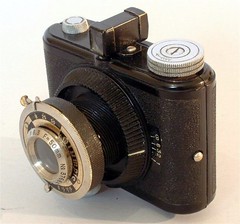
|
 
|
 
| |
| Olympic B, Olynar Special 50mm f/6.3 lens no.37684. Pictures courtesy of Adrian Gotts. (Image rights) | |

|
| Advertisement for Olympic cameras in The BJP Almanac 1937. Scan by rebollo_fr (Image rights) |
The Olympic B (オリンピックB型) has a tubular optical finder and an advance knob with a flat top. The shutter gives B, 25, 50 speeds selected by an index. The shutter plate is inscribed Olympic on one side, PAT. NO. 194303 and sometimes MADE IN JAPAN on the other. The lens is engraved OLYNAR SPECIAL 1:6.3 F=50mm N°xxxxx. The aperture scale is at the bottom of the shutter plate and reads 6.3, 8, 12.5, 16, 25 on some examples and 6.3, 8, 10, 12, 15 on others.[8] It seems that the 6.3 to 15 scale is found on the examples marked as made in Japan, which were perhaps those made for export, whereas the cameras with 6.3 to 25 scale have no such marking and have a smooth rectangular area on the back, around the red windows, instead of the grainy pattern visible on the camera pictured in this page.[9] The camera was sold in a box written OLYMPIC MOD. B and LENS OLYNER f:6.3 (the spelling of the lens name differs from the lens engraving).[10] At the time, the lens received quite unfavourable comments in an article by Kawara Kanji, where it is stated that the image is soft wide open and that there is strong vignetting at small apertures, the only satisfying aperture being f/8.[11]
The Olympic B was released in 1934, some months after the previous model. It is offered for ¥15 in the December 1934 and August 1936 advertisements cited above, along with the Olympic A,[12] and in another advertisement dated March 1937, along with the Super Olympic and Olympic Junior.[13] The advertisement placed by Asahi Bussan at the end of 1936 in The British Journal Photographic Almanac 1937 lists the Olympic B and C, and wrongly says that the model B has f/6.5 maximum aperture.[14]

|

|
Olympic B in a catalogue by Asahi Kōgaku Kōgyō, c.1938. Scan by rebollo_fr (Image rights) |
Olympic Junior and Olympic B in a leaflet by Riken Kōgaku Kōgyō, c.1939.[15] Scan by rebollo_fr (Image rights) |
The last advertisement for the Olympic B found in a Japanese magazine is dated May 1937,[16] but the camera was still sold for some time. The price was raised because of various special taxes levied after the outbreak of war with China.[17] The catalogue extract reproduced above, dated c.1938, shows the price of ¥17 (case ¥3.50 extra),[18] and the leaflet dated c.1939 has ¥19.[19] The camera is still mentioned for ¥19 in the official list of set prices compiled in October 1940 and published in January 1941.[20]
The Olympic Junior
The Olympic A was replaced by the Olympic Junior (オリンピックジュニアー) at the very end of 1936.[21] The new model is very similar to the Olympic B but only has B and 25 speed settings and an Olynar 50/8 lens. The shutter plate has a different design and is inscribed OLYMPIC JUNIOR on one side and PAT NO 194303 on the other. The shutter casing is silver instead of black. The lens is engraved OLYNAR 1:8 F=50mm NO. xxxxx and the aperture scale goes from 8 to 24. Various surviving examples have been observed, with four or five-digit lens numbers.[22]
 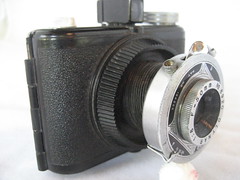 
|
     
|
| Olympic Junior, Olynar 50mm f/8 lens no.8920. Pictures by courtesy of an anonymous eBayer. (Image rights) |

|
| Advertisement for the Olympic Junior in Popular Photography February 1938. Scan by Rick Zolla (Image rights) |
The Olympic Junior appears for ¥8.50 in advertisements dated February and March 1937.[23] It is briefly mentioned in the advertisement placed by Asahi Bussan in The British Journal Photographic Almanac 1938, at the end of 1937.[24] It was also exported to the United States, and appears for $5.95 in an advertisement by Candid Camera Supply Co. dated February 1938.[25]
The Japanese price was raised to ¥10 in the catalogue by Asahi Kōgaku Kōgyō reproduced below, dated c.1938,[26] and to ¥12 in the leaflet dated c.1939, reproduced in the above section.[19] The camera is still mentioned in the January 1941 official price list, for ¥19 (same price category as the Olympic B).[27]

|
| Olympic Junior in a catalogue by Asahi Kōgaku Kōgyō, c.1938. Scan by rebollo_fr. (Image rights) |
The Olympic C
Description
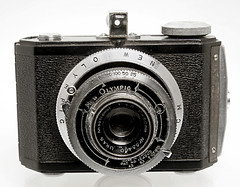
|
| Olympic C. Picture courtesy of Rick Soloway. (Image rights) |
The Olympic C (オリンピックC型) was released in mid 1936.[28] It has a different bakelite body with angled edges. The lens is front-cell focusing and the bakelite helical is used only to collapse or extend the lens and shutter assembly. The helical is usually driven by a massive metal ring at the base, engraved NEW OLYMPIC MOD. C 3X4CM. (Despite this engraving, the camera was always called Olympic C in the advertisements and the name written on the original box is "Olympic Mod. C".)[29] The knobs and the tubular finder are different from the previous models. The back is hinged to the right and is opened by sliding a button. The name Olympic is moulded in the bakelite at the top of the back and there are two uncovered red windows. There is a nameplate inscribed The Olympic Camera Works next to the back latch. (This is decorative only and is certainly not the maker's name, see Asahi Bussan.)
Variations
The regular Olympic C has a shutter plate inscribed NEW OLYMPIC at the top, PAT. NO. 194303 and sometimes MADE IN JAPAN at the bottom, with an AB logo for Asahi Bussan on the right. (Again, the mention of the country was perhaps added on the cameras made for export.) The speed settings are engraved T, B, 150, 100, 50, 25 in that order on the shutter rim. The aperture scale goes from 4.5 to 25. Early cameras have the distance scale at the front of the lens rim. The lens marking is UKAS 1:4.5 F=50mm Nr xxxx on the earliest examples, and UKAS Anastigmat 1:4.5 F=50mm Nr xxxxx slightly later.[30] Later cameras, with the distance scale on the outer edge of the rim, are more numerous (one such example is pictured above).
The Olympic CIII is known from an isolated example, pictured below. It has a different shutter plate, inscribed OLYMPIC at the top and MOD. CIII at the bottom, with the logo of Asahi Bussan on the side. The speed settings are the same, but are directly inscribed on the shutter plate, and the ring only has a moving red dot. The aperture scale stops at f/18 instead of f/25. The lens rim and engraving is similar to the late Olympic C, and no other difference is visible.
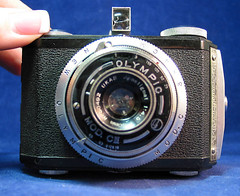 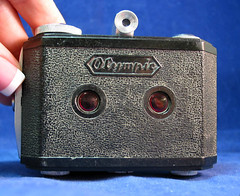
|
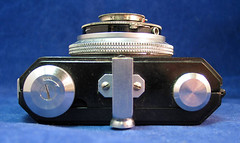 
|
| Olympic CIII, Ukas Anastigmat 50mm f/4.5 lens no.50492. Pictures by courtesy of Chuck Rubin. (Image rights) |
Commercial life

|
| Advertisement for Olympic cameras in The BJP Almanac 1938. Scan by rebollo_fr. (Image rights) |
The Olympic C appears for ¥24 in the August 1936 advertisement in Asahi Camera cited above.[31] The advertising picture shows a very early example, perhaps a prototype. It has the same advance knob as the Olympic A, B and Junior, the same bakelite ring at the base of the helical, and it has only T, B, 100, 50, 25 speed settings.
The regular version of the camera, with the older focusing ring, is offered for the same price in some of the February and March 1937 advertisements cited above.[32] It also appears in the advertisements placed in the 1937 and 1938 editions of The British Journal Photographic Almanac, respectively published in late 1936 and late 1937.[33]

|
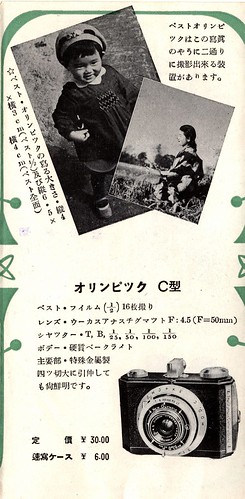
|
| Olympic C in a catalogue by Asahi Kōgaku Kōgyō, c.1938. Scan by rebollo_fr. (Image rights) |
Olympic C in a leaflet by Riken Kōgaku Kōgyō, c.1939. Scan by rebollo_fr. (Image rights) |
The camera is pictured with the later type of focusing ring in the catalogue by Asahi Kōgaku Kōgyō reproduced above, dated c.1938.[34] The price is now ¥28 (case ¥5 extra). The leaflet by Riken Kōgaku Kōgyō dated c.1939 reproduced next shows the price of ¥30 (case ¥6).[19] The camera is shown in its presentation box in an advertisement by Riken dated September 1939.[35] No later advertisement for the Olympic C is known so far, but the camera is still mentioned for ¥32 in the January 1941 official price list.[36]
The 4×4 models
The Olympic Four I
Description
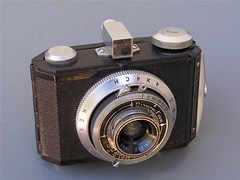  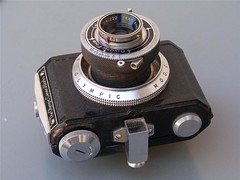
|
   
|
| Olympic Four I, Ukas Anastigmat 50mm f/4.5 lens no.80222, OLYMPIC FOUR marking, AB logo. Pictures courtesy of eBayer ipruksleica. (Image rights) |
The Olympic Four (オリンピックフォアー) is a version of the Olympic C taking 4×4cm pictures. It appeared in mid 1938[37] and was called in retrospect Olympic Four I (オリンピックフォアーⅠ型) after the introduction of the model II. This model is very similar to the Olympic C except for the finder and the back. There are three uncovered red windows because the rollfilm paper backing was not adapted for 4×4 exposures at the time. The helical ring is engraved NEW OLYMPIC MOD. C 4X4CM.
The lens and shutter are the same as on the Olympic C. It seems that the Olympic Four I only exists with the later type of focusing ring. Various types of shutter plates are known. They normally have PAT. NO. 194303 and sometimes MADE IN JAPAN in small characters at the bottom (surely for export). They differ by the marking at the top — OLYMPIC FOUR or NEW OLYMPIC — and the logo on the right — AB for Asahi Bussan or AKK for Asahi Kōgaku Kōgyō. All four combinations have been observed, those with the AB logo being presumably older:
- OLYMPIC FOUR marking, AB logo;[38]
- NEW OLYMPIC marking, AB logo;[39]
- OLYMPIC FOUR marking, AKK logo;[40]
- NEW OLYMPIC marking, AKK logo.[41]
The first of these markings has been observed on a camera having a flush metal part instead of the top right knob, perhaps an early feature.
Commercial life
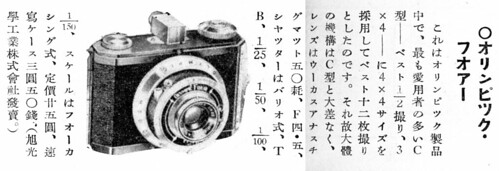
|
| Announcement of the Olympic Four in Asahi Camera June 1938. Scan by rebollo_fr. (Image rights) |
The Olympic Four was featured as a new product in the June 1938 issue of Asahi Camera, reproduced above.[42] The document mentions the Ukas Anastigmat f/4.5 lens and T, B, 25, 50, 100, 150 shutter speeds. The price is given as ¥25, with an extra ¥3.50 for the case.

|

|
| Advertisement in Shinkō Graph August 1938. Scan by rebollo_fr. (Image rights) |
Olympic Four in a catalogue by Asahi Kōgaku Kōgyō, c.1938. Scan by rebollo_fr. (Image rights) |
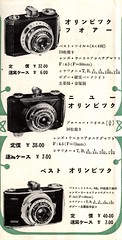
|
| Olympic Four (at the top) in a leaflet by Riken Kōgaku Kōgyō, c.1939. Scan by rebollo_fr. (Image rights) |
The Olympic Four appears at the slightly higher price of ¥29 (case ¥5 extra) in an advertisement in Shinkō Graph August 1938 and in a contemporary catalogue by Asahi Kōgaku Kōgyō, reproduced above.[43][44] The picture of the advertisement shows the speed scale in the reverse direction (25, 50, 100, 150, B, T) and yet another variation of the shutter plate, with thick stripes on both sides, OLYMPIC FOUR at the top, FISKUS at the top and an AB logo. The picture of the catalogue appears in most subsequent advertisements. It shows the normal speed scale (T, B, 150, 100, 50, 25) and the regular shutter plate design, with OLYMPIC FOUR and the AB logo — the bottom marking is illegible.
The price was soon raised to ¥32 (case ¥6), as appears in an advertisement dated May 1939,[45] and in the contemporary leaflet by Riken Kōgaku Kōgyō reproduced to the right.[19]

|
| Advertisement by Riken Kōgaku Kōgyō in Asahi Camera April 1940. Scan by rebollo_fr. (Image rights) |
The advertisements placed in Asahi Camera from March to June 1940 list the camera at an unchanged price, together with the Olympic Four II (see below).[46] The March and April advertisements show a picture of the Olympic Four I, whereas the later ones show the model II. These documents mention Yamashita Yūjirō Shōten, Banno Bōeki and Photo-News as authorized dealers for the camera.[47]
The Olympic Four still appears for ¥32 in the January 1941 official price list.[48] This is the last known mention of the camera.
Unusual variant or home-made camera
An article by Takesaki in Kurashikku Kamera Senka shows a picture of a camera which was probably made by a repairer or homebuilder from parts of an Olympic Four I.[49] It has the same bakelite body, viewfinder and advance knob; the back latch is moved to the other side of the body, the helical was perhaps replaced by a telescopic tube, with a plain ring at the base, and the lens and shutter assembly was replaced. The lens is a Hotoka Anastigmat 50mm f/3.5 with no serial number and the shutter is a Kikō-C giving 150–25, B, T speeds, inscribed KIKō–C at the top and KIGAWAKŌGAKU at the bottom, made by Kigawa and certainly taken from a Tsubasa Super Semi.
The Olympic Four II
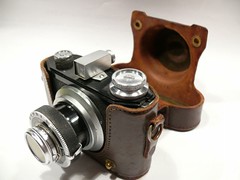  
|
   
|
| Olympic Four II, Ukas Anastigmat 50mm f/4.5 lens no.83490, late shutter plate. Pictures courtesy of Hubert Schorle (Bonn, Germany). (Image rights) |
The Olympic Four II (オリンピックフォアーⅡ型) is an updated version of the Olympic Four. It has a metal telescopic tube instead of the bakelite helical. The back latch is modified and consists of a long sliding bar, and the advance knob and film retaining knobs are different too. The lens is the same Ukas Anastigmat 50mm f/4.5 as on the previous models.
The early examples have the same NEW OLYMPIC and AKK shutter plate and the same speed engravings (T, B, 150, 100, 50, 25) as on the model I. This is the variant pictured in the advertisements observed so far. Some have MADE IN JAPAN under the lens, and others don't.[50] Later examples have 25, 50, 100, 150, B, T speed settings in that order and a slightly altered shutter plate, without the patent number at the bottom.[51]

|
| Advertisement by Riken Kōgaku Kōgyō in Asahi Camera May 1940. Scan by rebollo_fr. (Image rights) |
The Olympic Four II appears for ¥33 in advertisements dated December 1939 and March to June 1940.[52] These documents sometimes show a picture of the camera, with the older type of shutter plate.[53]
The camera is mentioned for ¥32 in the January 1941 official price list.[54] It is offered again for that price in an advertisement dated April 1941,[55] and it is listed for ¥37 (case extra ¥6.70) in a Japanese catalogue reportedly dated 1942.[56]
At least one example is known with a Heil Anastigmat lens and a shutter giving 5–200, B, T speeds with a HEIL nameplate screwed at the top of the shutter plate and an AKK logo on the right.[57] It was perhaps called "Heil Four".[58] (Many of the names used by Riken, like Adler or Heil, remind one of sinister times.)
Notes
- ↑ 1934 release date: Tanaka, pp.8 and 12 of Kurashikku Kamera Senka no.14.
- ↑ 2.0 2.1 See the pictures of the Rubette in Wilhelm's article in Photographica Cabinett no.44.
- ↑ Examples pictured in McKeown, p.747 (where it is misidentified as an Olympic Junior), in Tanaka, p.12 of Kurashikku Kamera Senka no.14, here at the AJCC, in this page of the Ricoh website, and observed in an online auction.
- ↑ Examples pictured in this article and in this page by Rick Soloway.
- ↑ Advertisement reproduced in Tanaka, p.8 of Kurashikku Kamera Senka no.14.
- ↑ Advertisement published in Sunday Mainichi 23 December 1934, formerly reproduced in the Gochamaze website (archived).
- ↑ Advertisement in Asahi Camera August 1936, reproduced in Kokusan kamera no rekishi, p.63.
- ↑ Tanaka, p.12 of Kurashikku Kamera Senka no.14, elaborates about the possibility that the f/6.3 aperture is expressed in US numbers.
- ↑ Aperture scale to 15 and MADE IN JAPAN marking: examples pictured in this page, in McKeown, p.747, in Sugiyama, item 4058 (misidentified as an Olympic Junior), in Zaisu, p.7 of Camera Collectors' News no.63 (the picture is faintly legible), here at the AJCC, and observed in online auctions. — Aperture scale to 25, no "made in Japan" marking and smooth rectangular area: example pictured in Tanaka, pp.12–3 of Kurashikku Kamera Senka no.14, and perhaps example observed in an online auction (with faintly legible pictures).
- ↑ Box pictured in Dokusha-dayori p.161 of Kurashikku Kamera Senka no.14, and box observed in an online auction.
- ↑ Kawara, reproduced on p.85 of Kurashikku Kamera Senka no.14.
- ↑ Advertisement in Sunday Mainichi, December 23, 1934, formerly reproduced at Gochamaze (archived). Advertisement in Asahi Camera August 1936, reproduced in Kokusan kamera no rekishi, p.63.
- ↑ Advertisement in Asahi Camera, reproduced in Kokusan kamera no rekishi, p.63.
- ↑ Advertisement in The British Journal Photographic Almanac 1937, p.668.
- ↑ The list of features of the Olympic Junior and B are swapped by mistake.
- ↑ Kokusan kamera no rekishi, p.335.
- ↑ See Japanese prices.
- ↑ Catalogue Olympic Products, c.1938, p.7.
- ↑ 19.0 19.1 19.2 19.3 Leaflet Riken Kōgaku no kamera to sōgankyō, c.1939.
- ↑ "Kokusan shashinki no kōtei kakaku", type 1, section 1.
- ↑ Kokusan kamera no rekishi, p.335, says that the camera was announced as a new model (新発売) in a December 1936 advertisement.
- ↑ Examples pictured in Sugiyama, item 4057, in Lewis, p.43, in Tanaka, p.13 of Kurashikku Kamera Senka no.14, in this page of the Ricoh website, in this page and this page at Asacame, and observed in online auctions.
- ↑ Advertisement in Camera Art February 1937 and advertisement in Asahi Camera March 1937, both reproduced in Kokusan kamera no rekishi, p.63. Advertisement in Shashin Salon March 1937, reproduced in Tanaka, p.9 of Kurashikku Kamera Senka no.14.
- ↑ Advertisement in The British Journal Photographic Almanac 1938, pp.694–5.
- ↑ Advertisement in Popular Photography, reproduced in Montanaman1's Flickr stream.
- ↑ Catalogue Olympic Products, c.1938, p.6.
- ↑ "Kokusan shashinki no kōtei kakaku", type 1, section 1.
- ↑ The earliest advertisement listed in Kokusan kamera no rekishi, p.335, is dated June 1936.
- ↑ Original box pictured in an advertisement published in Sunday Mainichi 10 September 1939, formerly reproduced in the Gochamaze website (archived).
- ↑ UKAS: example observed in an online auction. UKAS Anastigmat: example observed in a Chinese forum.
- ↑ Advertisement reproduced in Kokusan kamera no rekishi, p.63.
- ↑ Advertisement in Camera Art February 1937, reproduced in Kokusan kamera no rekishi, p.63. Advertisement in Shashin Salon March 1937, reproduced in Tanaka, p.9 of Kurashikku Kamera Senka no.14.
- ↑ Advertisement in The British Journal Photographic Almanac 1937, p.668, and in The British Journal Photographic Almanac 1938, pp.694–5.
- ↑ Catalogue Olympic Products, c.1938, p.8.
- ↑ Advertisement] in Sunday Mainichi, September 10, 1939, formerly reproduced at Gochamaze (archived).
- ↑ "Kokusan shashinki no kōtei kakaku", type 1, section 2.
- ↑ Kokusan kamera no rekishi, p.335, says that it was featured in the new products column of the June 1938 issue of Asahi Camera.
- ↑ Examples pictured in this page, and observed in an unknown website.
- ↑ Example observed in an online auction.
- ↑ Example pictured in McKeown, p.746 (where the camera is called "New Olympic C 4×4cm").
- ↑ Examples pictured in Sugiyama, item 4059 (where the camera is called "New Olympic C"), in this page at Asacame, in this page of the Western Photographic Historical Society (archived), in this page of the Yamada Camera Museum, offered for sale by dealers and observed in online auctions.
- ↑ Column in Asahi Camera June 1938, p.914.
- ↑ Advertisement in Shinkō Graph August 1938, p.2.
- ↑ Catalogue Olympic Products, c.1938, p.9.
- ↑ Advertisement in Shinkō Graph, reproduced in Tanaka, p.9 of Kurashikku Kamera Senka no.14.
- ↑ Advertisement in Asahi Camera March 1940, reproduced in Kokusan kamera no rekishi, p.104, advertisement in Asahi Camera April 1940, p.A86, reproduced in Kokusan kamera no rekishi, p.64, advertisement in Asahi Camera May 1940, p.A83, and advertisement in Asahi Camera June 1940, reproduced in Kokusan kamera no rekishi, p.64.
- ↑ The advertisement dated March 1940 only mentions Yamashita; those dated April, May and June mention the three companies.
- ↑ "Kokusan shashinki no kōtei kakaku", type 1, section 2.
- ↑ Camera pictured in Takesaki, p.107 of Kurashikku Kamera Senka no.53.
- ↑ With MADE IN JAPAN: examples offered for sale by a Chinese dealer. Without MADE IN JAPAN: example observed in an online auction.
- ↑ Examples are pictured in Sugiyama, item 3041 (misidentified as a "New Olympic"), in Tanaka, pp.15–6 of Kurashikku Kamera Senka no.14, and in this page at Japan Family Camera.
- ↑ Advertisement in Shinkō Graph December 1939, reproduced in Tanaka, p.9 of Kurashikku Kamera Senka no.14, advertisement in Asahi Camera March 1940, reproduced in Kokusan kamera no rekishi, p.104, advertisement in Asahi Camera April 1940, p.A86, reproduced in Kokusan kamera no rekishi, p.64, advertisement in Asahi Camera May 1940, p.A83, and advertisement in Asahi Camera June 1940, reproduced in Kokusan kamera no rekishi, p.64.
- ↑ Advertisement in Shinkō Graph December 1939, reproduced in Tanaka, p.9 of Kurashikku Kamera Senka no.14, advertisement in Asahi Camera May 1940, p.A83, and advertisement in Asahi Camera June 1940, reproduced in Kokusan kamera no rekishi, p.64.
- ↑ "Kokusan shashinki no kōtei kakaku", type 1, section 2.
- ↑ Advertisement in Gakusei no Kagaku April 1941, formerly reproduced at Gochamaze (archived).
- ↑ Catalogue by Gold Camera Kōgyō-sho observed in an online auction.
- ↑ Example pictured in Tanaka, p.15 of Kurashikku Kamera Senka no.14. A small version of the picture is reproduced in this page of the Ricoh official website.
- ↑ Tanaka, p.8 of Kurashikku Kamera Senka no.14, briefly mentions a Heil Four but does not elaborate.
Bibliography
Original documents
- Asahi Kōgaku Kōgyō. Olympic Products. Catalogue published c.1938 (date not indicated). Document reproduced in this Flickr set by Rebollo_fr.
- Asahi Camera June 1938. "Atarashii kikai to zairyō" (新しい機械と材料, New equipment and machinery). P.914.
- Asahi Camera. Advertisement by Riken Kōgaku Kōgyō:
- April 1940, p.A86;
- May 1940, p.A83.
- Kawara Kanji (河原侃二), "Orinpikku kamera (B-gata) no atarashii tsukaikata" (オリンピックカメラ[B型]の新しい使ひ方, Using the Olympic B). Geijutsu Shashin Kenkyū (芸術写真研究), November 1936. Reproduced in Kamera Rebyū: Kurashikku Kamera Senka (カメラレビュー クラシックカメラ専科) / Camera Review: All about Historical Cameras no.14, October 1989. No ISBN number. Rikō kamera no subete (リコーカメラのすべて, special issue on Ricoh). P.85.
- "Kokusan shashinki no kōtei kakaku" (国産写真機の公定価格, Set prices of the Japanese cameras), listing Japanese camera production as of October 25, 1940 and setting the retail prices from December 10, 1940. Published in Asahi Camera January 1941 and reproduced in Shōwa 10—40nen kōkoku ni miru kokusan kamera no rekishi (昭和10〜40年広告にみる国産カメラの歴史, Japanese camera history as seen in advertisements, 1935—1965). Tokyo: Asahi Shinbunsha, 1994. ISBN 4-02-330312-7. Pp.108—9. Type 1, sections 1 and 2.
- Riken Kōgaku Kōgyō. Riken Kōgaku no kamera to sōgankyō (理研光学のカメラと双眼鏡, Riken Kōgaku cameras and binoculars). Leaflet published c.1939 (date not indicated). Document reproduced in this Flickr set by Rebollo_fr.
- Shinkō Graph (新光グラフ) August 1938. Advertisement by Asahi Kōgaku Kōgyō on p.2.
- The British Journal Photographic Almanac 1937, edited by Arthur J. Dalladay. London: Henri Greenwood & Co., Ltd. Publication date not indicated, certainly late 1936. Advertisement by Asahi Bussan on p.668.
- The British Journal Photographic Almanac 1938, edited by Arthur J. Dalladay. London: Henri Greenwood & Co., Ltd. Publication date not indicated, certainly late 1937. Advertisement by Asahi Bussan on pp.694–5.
- Ueda Shashinki-ten. Saishin kogata kamera (最新小型カメラ, Latest small cameras). Catalogue published c.1935, date not indicated. Document reproduced in this Flickr album by Rebollo_fr. The catalogue briefly lists the Olympic A and B.
Recent sources
- Arimura Katsumi (有村克巳). "Rikō Ryakushi" (リコー略史, Ricoh short history). Kamera Rebyū: Kurashikku Kamera Senka (カメラレビュー クラシックカメラ専科) / Camera Review: All about Historical Cameras no.14, October 1989. No ISBN number. Rikō kamera no subete (リコーカメラのすべて, special issue on Ricoh). Pp.6–7.
- Asahi Camera (アサヒカメラ) editorial staff. Shōwa 10–40nen kōkoku ni miru kokusan kamera no rekishi (昭和10–40年広告にみる国産カメラの歴史, Japanese camera history as seen in advertisements, 1935–1965). Tokyo: Asahi Shinbunsha, 1994. ISBN 4-02-330312-7. Items 41–4 and 47–8. (See also the advertisements for items 46 and 323 and the picture on p.427.)
- Dokusha-dayori (読者だより, Readers' letters) Kamera Rebyū: Kurashikku Kamera Senka (カメラレビュー クラシックカメラ専科) / Camera Review: All about Historical Cameras no.14, October 1989. No ISBN number. Rikō kamera no subete (リコーカメラのすべて, special issue on Ricoh). P.161.
- The Japanese Historical Camera. 日本の歴史的カメラ (Nihon no rekishiteki kamera). 2nd ed. Tokyo: JCII Camera Museum, 2004. Pp.18 and 21.
- Lewis, Gordon, ed. The History of the Japanese Camera. Rochester, N.Y.: George Eastman House, International Museum of Photography & Film, 1991. ISBN 0-935398-17-1 (paper), 0-935398-16-3 (hard). P.43.
- McKeown, James M. and Joan C. McKeown's Price Guide to Antique and Classic Cameras, 12th Edition, 2005-2006. USA, Centennial Photo Service, 2004. ISBN 0-931838-40-1 (hardcover). ISBN 0-931838-41-X (softcover). Pp.746–7.
- Sugiyama, Kōichi (杉山浩一); Naoi, Hiroaki (直井浩明); Bullock, John R. The Collector's Guide to Japanese Cameras. 国産カメラ図鑑 (Kokusan kamera zukan). Tokyo: Asahi Sonorama, 1985. ISBN 4-257-03187-5. Items 3041 and 4057–9.
- Takesaki (竹崎春智). "Tesaguri no tameshitori to shiage" (手探りの試し撮りと仕上げ, Various tries at taking pictures). Kamera Rebyū: Kurashikku Kamera Senka (カメラレビュー クラシックカメラ専科) / Camera Review: All about Historical Cameras no.53, December 1999. ISBN 4-257-13026-1. Tokushū: 50-nin no korekutā ni kiku watakushi no ichi-dai (特集:50人のコレクターに聞く私の1題, 50 stories told by camera collectors). Pp.106–7.
- Tanaka Masao (田中政雄). "Rikō kamera no nagare" (リコーカメラの流れ, Evolution of the Ricoh cameras). Kamera Rebyū: Kurashikku Kamera Senka (カメラレビュー クラシックカメラ専科) / Camera Review: All about Historical Cameras no.14, October 1989. No ISBN number. Rikō kamera no subete (リコーカメラのすべて, special issue on Ricoh). Pp.8–11.
- Tanaka Masao (田中政雄). "Senzen no kamera 1: Orinpikku" (戦前のカメラ1・オリンピック, Prewar cameras 1: Olympic). Kamera Rebyū: Kurashikku Kamera Senka (カメラレビュー クラシックカメラ専科) / Camera Review: All about Historical Cameras no.14, October 1989. No ISBN number. Rikō kamera no subete (リコーカメラのすべて, special issue on Ricoh). Pp.12–6.
- Wilhelm, Willi. "Kamerproduktion bei Ruberg & Renner in Hagen" (Camera production by Ruberg & Renner in Hagen). In Photographica Cabinett no.44 (September 2008). Pp.33–45. (Contains information on the original Rubette, copied by the Olympic A.)
- Zaisu Ikon (座椅子遺恨, probably a pseudonym of Y. Saji). "Besuto sanka (M–O)" (ベスト讃歌[M–O], Vest hymn [M–O]). In Camera Collectors' News no.63 (September 1982). Nishinomiya: Camera Collectors News-sha. P.7. (Shows an Olympic B and an Olympic Four II.)
Links
General links
In English:
In Japanese:
- Pages from the Ricoh corporate site and the Ricoh camera list:
- Pages of the Asacame website:
- Olympic Junior (the first camera pictured is a Baby Chrome, not an Olympic) among the 127 film cameras from A to Z
- Riken 127 film cameras with an Olympic Junior, an Olympic C and an Olympic Four I
- Olympic A and Olympic B in a page of the AJCC website
- Olympic Junior in the Camera database of the Center of the History of Japanese Industrial Technology
- Ricoh exhibition at the JCII camera museum, with an Olympic A
- Olympic Four I in the first page of the Yamada Camera Museum
- Olympic Four II at Japan Family Camera (the back picture mistakenly shows a Vest Olympic)
- Prewar Japanese 127 camera page at Nekosan's website (archived), with an Olympic C and an Olympic Four II
Original documents
In English:
- Advertisement for the Olympic Junior published in the February 1938 issue of Popular Photography, reproduced in Montanaman1's Flickr stream
| Asahi Bussan and Riken prewar and wartime cameras () | ||
|---|---|---|
| rigid or collapsible | ||
| Vest Adler | Gokoku | Semi Kinsi | Letix | Olympic | New Olympic | Regal Olympic | Semi Olympic | Super Olympic | Vest Olympic | Riken No.1 | Ricohl | Roico | Seica | Zessan | ||
| folders | pseudo TLR | TLR |
| Semi Adler | Adler III | Adler A | Adler B | Adler C | Adler Four | Adler Six | Gaica | Heil | Kinsi | Chukon Ref | Ricohflex | Ricohflex B |
